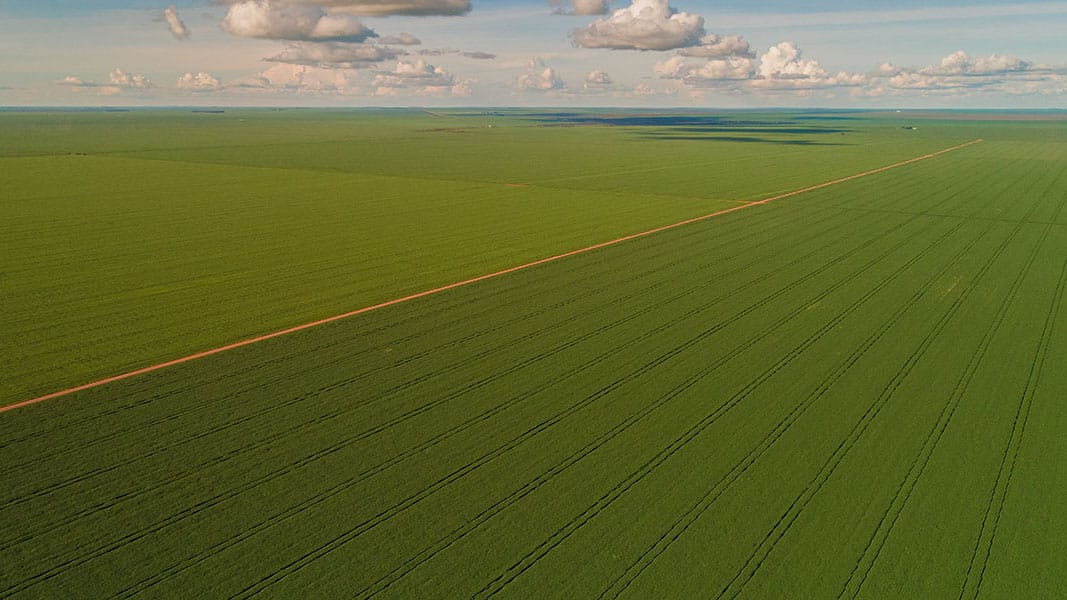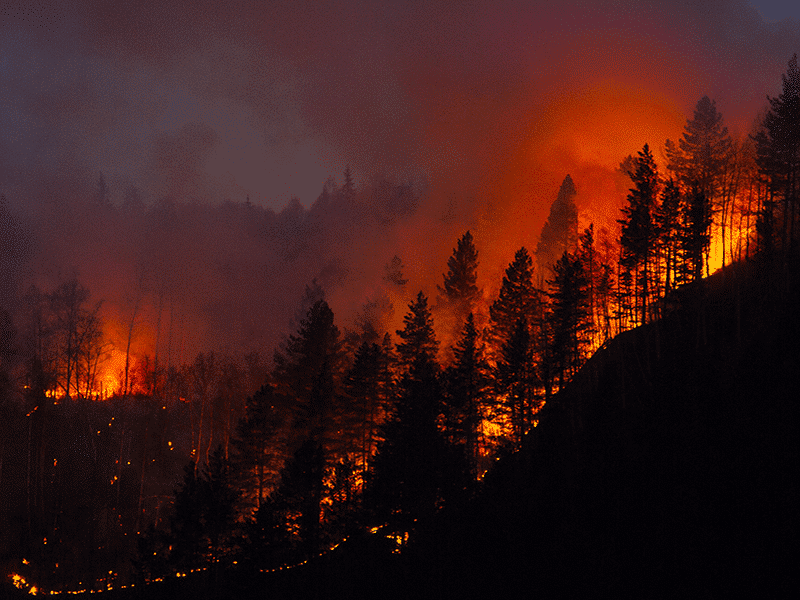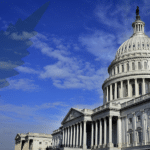On his very first day in office, President Joe Biden initiated the process of rejoining the Paris climate accord, which his predecessor Donald Trump had abrogated. The Biden administration wasted little time in announcing several steps it was taking to deal with the climate crisis.
The United States has a special responsibility in this regard. It is the world’s second highest greenhouse gas emitter. It is also among the highest per capita emitters — well ahead of the top emitter in absolute terms, China.
The United Nations’ Intergovernmental Panel on Climate Change (IPCC) has warned of devastating consequences for the planet within a generation — worsening food shortages, wildfires, droughts, coastal flooding, and a global crisis with “no documented historic precedent” — unless decisive measures are implemented.
The urgency of the matter could hardly be clearer, but the real test will be in the follow-through.
Agribusiness & Climate Change
While much of the climate change conversation has focused on the role of fossil fuels in the energy and transportation sectors, industrial agriculture and food production are also major contributors to global warming. Poor soil management and excessive use of chemical fertilizers increase emissions of both carbon and nitrous oxide, another greenhouse gas. And livestock, especially cattle through their digestive process, produce methane, which is actually a more potent greenhouse gas than carbon.
Biden’s plan to make agriculture carbon neutral could lead to new opportunities for hemp farmers.
According to the Environmental Protection Agency, farming practices account for nearly 10% of total US greenhouse gas emissions.1 This figure is significantly lower than the 2019 report by the UN’s IPCC, which maintains that one third of human-caused greenhouse gas emissions comes from agriculture and the global food production system. Reducing agriculture’s carbon footprint is therefore central to addressing the climate crisis, and this could have a major impact on how food is grown, distributed, and consumed.
Biden’s plan to make agriculture carbon neutral could lead to new opportunities for hemp farmers. Hemp’s potential as a cash crop that can sequester carbon and remediate the soil bodes well for the future of industrial cannabis (with less than 0.3 percent THC). But which farmers will benefit? Will Biden’s policies help small farmers who are struggling to survive? And what will this mean in terms of justice for Black and Native American farmers?
Vilsack is Back
Many environmentalists and farmer advocates have raised concerns about Biden’s choice to lead the US Department of Agriculture (USDA). They say that he’s too close to Big Ag and his background and record call into question the administration’s commitment to tackling the climate conundrum.
Tom Vilsack, Biden’s choice for USDA director, has been at the helm of that department before. He was two-term governor of Iowa, a key farming state, before serving as Agriculture Secretary throughout the Obama years.
Vilsack will head a department whose diverse responsibilities include not only helping the nation’s farms but overseeing the National Forests, the food stamp program, and regulation of food quality, nutrition, and labeling.
Vilsack is emphasizing his vow to accelerate USDA programs to combat climate change in a way that will be good for the nation’s farmers. “Agriculture writ large is ready for this, much more than before,” said Vilsack in a Jan. 22, 2021, interview with Iowa’s Storm Lake Times.
“We can create a whole new suite of revenue streams to protect [farmers] from the vagaries of trade,” Vilsack stated, saying his USDA will launch pilot projects on carbon capture that could be formalized as full-scale programs in the 2023 farm bill. He broached making “carbon sequestration” through soil conservation the basis of a “cap-and-trade market,” allowing farmers to make money by keeping carbon locked in the soil.
Existing USDA programs established to protect soil, such as the Conservation Reserve Program and the Conservation Stewardship Program, would be folded into a carbon-trading program that could be overseen by the Commodity Credit Corporation, a USDA entity dating to the New Deal era, designed to stabilize crop prices.
Incentivizing carbon capture and promoting soil restoration will require a major shift away from fossil fuels and toward renewable energy and regenerative farming. Is Vilsack the best person to lead the charge?
Mixed Reviews
Vilsack has gotten positive reviews from some producers of organic crops and foods for his promotion of their sector during his first go-round as Agriculture Secretary. “There’s been significant expansion and interest in organics,” Vilsack told Reuters in an April 2015 interview. “Both the number of producers expanding and the sales expanding are an indication that this is a fast-growing aspect of agriculture.”2
Agriculture, one of the biggest contributors to the climate crisis, must be a key part of the solution.
And when Vilsack was running the USDA, he was supportive of the 2014 Farm Bill, which allowed the cultivation of federally legal hemp crops on a limited experimental basis. Jonathan Miller, general counsel to the US Hemp Roundtable, said in a statement regarding Vilsack’s reappointment: “The USDA under Vilsack recognized that ‘market research’ under the 2014 Farm Bill included product sales . . . and facilitate[ed] the initial growth of the program, setting the table for the 2018 Farm Bill.”
Vilsack was also a staunch defender of the “food stamp” program — officially the Supplemental Nutrition Assistance Program (SNAP) — which the USDA oversees. Speaking before a meeting of the DC-based anti-hunger group Food Research & Action Center in March 2015, Vilsack said the program was being unfairly targeted by Republican lawmakers, dismissing claims that it was fraught with fraud and abuse.
“Why is it that [lawmakers] are picking on the SNAP program?” Vilsack asked. “Because it works. If these people were really serious about reducing SNAP and helping folks why wouldn’t they consider raising the minimum wage?”
But how does all this square with Vilsack’s “revolving door” relationship with Big Ag and the increasing corporate consolidation of agribusiness, which he failed to oppose as Agriculture Secretary? Today, Big Ag broadly overlaps with Big Pharma and the biotech industry, thanks partly to policies championed by Vilsack that have disadvantaged family and minority farmers, while exacerbating the climate crisis.
Climate Contradiction
A paradox can be seen in Vilsack’s current advocacy of climate programs. The biotech-dependent, fertilizer-intensive agricultural model he has promoted inherently facilitates monocropping — economies of scale in which vast areas are planted with a single crop.
This is certainly the case with federally subsidized corn, which is grown for animal feed and is the source of high-fructose corn syrup that has become ubiquitous in junk and processed foods, to the detriment of public health; and corn-derived ethanol is a mandated biofuel additive for gasoline. This kind of aggressive, business-as-usual monocropping, coupled with over-reliance on petrochemical fertilizers and irrigation, is depleting soils of nutrients, polluting land and water, and heating the atmosphere.
A December 2020 study in the publication Earth’s Future, journal of the American Geophysical Union, was ominously headlined: “The Hidden Costs of Land Degradation in US Maize Agriculture.”
It found that one third of current annual US use of nitrogen fertilizer in corn cultivation “is used to compensate for the long-term loss of soil fertility through erosion and organic matter loss. This leads to over a half billion dollars per year in extra fertilizer supply costs to US farmers.” The authors (including one from the USDA’s Agricultural Research Service) called for measures to “reduce both the input costs and environmental impacts of agriculture through the restoration of . . . organic matter in agricultural soils.”
The problem is global in scope. A Special Report on Climate Change was released by the UN Inter-governmental Panel on Climate Change in August 2019, focusing on links between greenhouse gas emissions and desertification, land degradation, and food security. The report warned that the “rise in global temperatures, linked to increasing pressures on fertile soil,” risks “jeopardizing food security for the planet.” According to the panel about a quarter of the Earth’s ice-free land area is subject to extensive human-induced degradation, involving soil erosion, desertification, and dust storms.
The impact of global warming has led to “shifts of climate zones in many world regions,” exacerbating degradation and leading to extreme weather conditions, such as floods and droughts, according to the UN report: “The stability of food supply is projected to decrease as the magnitude and frequency of extreme weather events that disrupt food chains increases.”
Megadrought
Another study, published in Science (April 2020) and prepared by scholars with Columbia University’s Earth Institute, had this sobering title: “Large contribution from anthropogenic warming to an emerging North American megadrought.”
The Earth Institute asserted in a press release: “A new study says the time has arrived: a megadrought as bad or worse than anything even from known prehistory is very likely in progress, and warming climate is playing a key role.”
Global warming has pushed what would have been a moderate drought in southwestern North America into megadrought territory.
“Earlier studies were largely model projections of the future,” author Park Williams, bioclimatologist at Columbia University, said in the news release. “We’re no longer looking at projections, but at where we are now. We now have enough observations of current drought and tree-ring records of past drought to say that we’re on the same trajectory as the worst prehistoric droughts.”
Examining rings from many thousands of trees in old-growth forests across the Southwest and Rocky Mountain states as well as California, the researchers charted dozens of droughts across the region, starting in 800 AD. Four stood out as so-called megadroughts, with extreme aridity lasting decades: the late 800s, mid-1100s, the 1200s, and the late 1500s. After 1600, there were other droughts, but none on this scale. (The one in the 1200s was likely a cause of the sudden decline of the indigenous Anasazi civilization, the so-called cliff-dwellers, in the Southwest.)
“Their conclusion: as measured against the worst 19-year increments within the previous episodes, the current drought is already outdoing the three earliest ones,” Earth Institute said. “The fourth, which spanned 1575 to 1603, may have been the worst of all . . .”
The report’s abstract states grimly: “Global warming has pushed what would have been a moderate drought in southwestern North America into megadrought territory . . . This appears to be just the beginning of a more extreme trend toward megadrought as global warming continues.”
The implications are grave for vast areas of the American West, where agribusiness empires and sprawling cities have been built on some of the continent’s most arid lands.
Cap-and-Trade
Vilsack’s favored strategy of carbon trading is viewed warily by many environmentalists, given the scale of the climate crisis and the dubious track-record of carbon trading schemes thus far.
Several states are already trading carbon credits through regional compacts such as the Regional Greenhouse Gas Initiative, or RGGI, covering the Northeast and mid-Atlantic states. President Obama was hoping to instate the program at the federal level through a bill called the American Clean Energy & Security Act, which failed to pass.
In November 2009, the New York Times reported on an embarrassing episode in which the Obama administration attempted to restrain two Environmental Protection Agency attorneys who went public with criticisms of the carbon-trading strategy. The lawyers, Laurie Williams and Allan Zabel, a married couple based in San Francisco, released a YouTube video, titled “The Huge Mistake,” and an accompanying opinion piece in the Washington Post, “Democrats’ climate bill failure.”
Their critique centered around the concept of “offsets” — carbon credits for those who (supposedly) clean up beyond what is legally required.3 Williams and Zabel claimed that the carbon-trading program already in place in the European Union had resulted in “higher energy prices for consumers,” “harmful price volatility,” “billions in windfall profits for utilities,” and (for all that) “few greenhouse gas reductions.”
Their claims were backed up by a harshly critical BBC study of the European Union carbon-trading program, released in June 2007, two years after the program was launched. According to the BBC study: “The EU’s carbon trading scheme has increased electricity bills, given a windfall to power companies and failed to cut greenhouse gases…”
As an alternative, Williams and Zabel proposed carbon fees to make fossil fuels more expensive than “green energy” — geothermal, solar and wind.
Subprime Carbon?
Charles Komanoff of the New York-based Carbon Tax Center, a group that advocates for the kind of solution proposed by Williams and Zabel, is not completely dismissive of Vilsack’s proposed program. “A federal carbon cap-and-trade program isn’t in my opinion an inherently evil or corrupt means to pay for soil conservation,” he tells Project CBD. “Soil conservation programs aren’t sketchy and easily game-able scams like tropical tree-planting or paying putative factories in China to not emit climate-damaging refrigerants. They’re verifiable and tangible.”
Nevertheless, he adds: “The best way to pay for soil carbon sequestration is with general revenues and/or USDA funding pots. After all, sequestering carbon is good not just for climate but for soil. Failing that, if the funding source has to be priced carbon emissions, a carbon tax is preferable to cap-and-trade.”
In 2009, amid the Wall Street crash and economic freeze, Friends of the Earth warned of the financialization of carbon in a report titled “Subprime Carbon?”
As policymakers debate Wall Street reform, there is little attention being paid to whether new regulations will be adequate to govern carbon trading and the carbon derivatives markets, which many experts believe could become larger than credit derivatives markets.
Most proposed climate bills rely on cap-and-trade systems to achieve greenhouse gas reductions . . . But these bills do not seek to regulate carbon trading as a massive new derivatives market, which is, in fact, what it is… [E]xisting financial regulations . . . are inadequate to govern carbon trading, creating a potentially huge regulatory gap . . . [L]essons from the current financial crisis apply to carbon markets. In particular, it raises concerns about “subprime carbon,” risky carbon credits based on uncompleted offset projects (projects designed to sequester or reduce greenhouse gases).
Subprime carbon credits may ultimately fail to reduce greenhouse gases and, like subprime mortgages, could collapse in value, yet they are already being securitized and resold in secondary markets.
Biofuel Booster
Vilsack was also leading voice in the Obama administration for biofuels — fuels derived from crops such as corn (or hemp) rather than fossil hydrocarbons. Biofuels were aggressively promoted at the time as a measure against global warming, and Vilsack pushed for mandating their use in the American auto fleet.
It’s not clear that biofuels put any less carbon into the atmosphere than gasoline.
Vilsack’s enthusiasm for biofuels dates to his stint as governor of Iowa, the country’s biggest producer both of corn and corn-derived ethanol. Not surprisingly, Growth Energy, the leading biofuel trade association, has issued a statement in strong support of Vilsack’s re-appointment to the USDA. So has the Iowa Biodiesel Board.
Biofuel blends typically contain corn-derived ethanol (10%) mixed with petrol (90%), though some fuels include much higher ethanol content than regular gasoline.
However, it’s not clear that on balance biofuels put any less carbon into the atmosphere than gasoline.
The burning of biofuels releases carbon, but they are deemed “carbon neutral” by US Energy Department, which maintains that the carbon released by biofuels is offset by the carbon absorbed as the corn, hemp or other biomass is cultivated. This notion has been questioned by critics, who argue that emissions from processing and fertilizer production should also be factored into the biofuel equation. They also point out that ethanol burns less efficiently than gasoline.
Additional concerns have been raised about biofuel-driven demand inflating grain prices and the diversion of land from the production of food crops, which contribute to food insecurity and hunger.
“Mr. Monsanto”
Critics have drawn attention to Vilsack’s role in enthusiastically promoting the interests of Big Ag and associated industries — especially biotechnology — going back to his time as Iowa governor and throughout his term as USDA Secretary.
In 2001, the Biotechnology Industry Organization (BIO) named Vilsack as “Governor of the Year” for his “support of the industry’s economic growth and agricultural biotechnology research.” It cited his creation of a “Governors’ Biotechnology Partnership,” bringing private companies to the table in helping to craft policy.
The Minnesota-based Organic Consumers Association notes that Vilsack, as Obama’s USDA chief, Vilsack approved more new genetically modified organisms (GMOs) than any secretary before him or since — winning him the epithet “Mr. Monsanto.” The long list of GMO seeds approved by Vilsack’s USDA include several of Monsanto’s Roundup Ready varieties — specially designed to withstand the Roundup (glyphosate) herbicide, also produced by Monsanto.
Today, agrochemical companies are also the world’s largest seed companies. And while conventional hybrid breeding has long been employed to produce high-yield varieties, recombinant DNA technology is now used to create genetically modified seeds with specific traits such as pesticide resistance.
Some of Vilsack’s approvals were challenged in court by groups such as the Center for Food Safety and the Organic Seed Alliance. In September 2009, a federal judge held up USDA approval of Monsanto’s Roundup Ready sugar beets, finding that contamination could cause the “potential elimination of farmer’s choice to grow non-genetically engineered crops, or a consumer’s choice to eat non-genetically engineered food.” The judge ordered the USDA to carry out an environmental impact study before the approval could go ahead.
A 2015 study by USDA scientists found that contamination was indeed happening with Roundup Ready alfalfa. It was escaping from farms in California, Idaho, and Washington, and going feral, potentially contaminating fields of non-GMO alfalfa.
This has far-reaching implications, explains Alexis Baden-Mayer, political director of the Organic Consumers Association: “Contamination of non-GMO seeds by crops genetically engineered to resist Roundup can affect neighboring farms. The genetic trait of resistance can be passed from plant to plant through soil microbiology, leading to pesticide-resistant weeds.”
Exports of US-grown GMO corn to China were barred by Chinese authorities in 2013, because the variety, known as Agrisure Viptera, had not been approved by Beijing’s Agriculture Ministry. This cost US farmers over $1.5 billion and become a matter of litigation. Syngenta, the company that produced the GMO strain, eventually agreed to a $900 million settlement.
Comments Baden-Mayer: “It’s very unkind to the farmers to say, ‘We want you to start buying this crop now, but we aren’t sure you’re gonna be able to export it this season.’ It’s shameful on the part of the federal government to let corporations that have such control over the market to start selling these traits before farmers have export markets for them. In this case, it had a devastating impact on farmers . . . and Vilsack was fine with that.”
Corporate Consolidation
Recent years have seen a consolidation of the GMO seed industry, which is now dominated by just four companies. Ironically, Swiss-based Syngenta was itself taken over in 2016 by Beijing’s state-owned China National Chemical Corporation (CNCC, also known as ChemChina). Also in 2016, Monsanto was bought out by Bayer, the Swiss-based biotech/pharmaceutical conglomerate, and folded into Bayer Crop Science. Two years later, Dow Chemical and DuPont merged their seed and agrochemical subsidiaries into a new corporate behemoth known as Corteva. The fourth giant of the cartel is German-owned BASF.
“GMOs haven’t delivered on promise to simplify farming,” Baden-Mayer says. “They promised agriculture that would mean less chemicals, less labor, less money — but it has done the exact opposite.”
She sees a vicious cycle at work. After Roundup-resistant weeds predictably started to emerge, the herbicide Dicamba, produced by BASF, was marketed (under the name Engenia) to kill Roundup-resistant weeds. This gave Monsanto the opportunity to develop Dicamba-resistant soy seeds, dubbed Xtend, in a partnership with BASF — a marketing strategy that provoked anti-trust litigation in the US courts in 2019. And each time the cycle goes round there are more adverse ecological effects.
“Dicamba is drift-prone,” Baden-Mayer says. “This is something Vilsack knew when he approved Dicamba-resistant seeds. It is damaging what are called ‘off-target” crops’ — a terrible euphemism. We are seeing a huge new experiment in the brave new world of GMO-based industrial agriculture.”
Suppressing Science
The dangers of a pesticide-laden environment were underscored by an August 2018 verdict against Monsanto in a case brought by a cancer sufferer in California. A San Francisco jury unanimously found that Monsanto was responsible for Dewayne “Lee” Johnson’s non-Hodgkin’s lymphoma through his on-the-job exposure to Roundup. Jurors found that Monsanto had “acted with malice or oppression” when it sold glyphosate to Johnson’s employer, the Benicia Unified School District, without informing of its potential health risks. Monsanto was ordered to pay $289 million in damages to the sickened school grounds-keeper.
Vilsack’s record on scientific integrity at USDA was appalling.
The group Public Employees for Environmental Responsibility (PEER) has called on the Senate to reconsider Vilsack’s confirmation, accusing him of a “disturbing suppression of USDA science.” PEER says USDA scientists have come forward with numerous examples of Vilsack issuing “directives not to publish data on certain topics of particular sensitivity to industry” and “orders to rewrite scientific articles already accepted for publication in a peer-reviewed journal to remove sections that could provoke industry objections.”
The PEER statement also accused Vilsack of “inordinate, sometimes indefinite, delays in approving submission for publication of scientific papers that may be controversial,” “restrictions on topics that USDA scientists may address in conference presentations” and even “targeting USDA scientists who industry identified as troublesome for harassment.”
“Tom Vilsack’s record on scientific integrity at USDA was appalling,” stated PEER executive director Tim Whitehouse, charging that Vilsack’s appointment is at odds with the Biden pledge to respect “science and truth.” He added: “Government research documenting what is really going in American agriculture does not need a corporate filter.”
GMO Labeling Controversy
In 2016. Congress passed the National Bioengineered Food Disclosure Standard, requiring the USDA to establish a labeling standard for food with GMOs.
But, in a pro-industry measure permitted by the law, USDA regulations issued in December 2018 (set to take effect in January 2022) allow three methods for labeling food products — plain text, a “BE” symbol (for bio-engineered), or “electronic or digital disclosure methods.” This last option was considered a free ride for the industry, as it takes a conscious effort by the consumer to decipher. And (intentionally or not) it discriminates against the poor, elderly, and others less likely to carry a smartphone to the grocery store.
Sen. Bernie Sanders was among those who called the law a “toothless” and confusing national standard.
But Vilsack went to bat aggressively for this gift to the biotech industry, telling the New York Times: “The way to go, long-term, is to embrace a 21st-century answer to this problem . . . an extended bar code or some mechanism [through which] consumers who are interested in all the information about a product could obtain it fairly easily, either through their smartphone or through a scanner that would be available in grocery stores.”
Also as permitted by a loophole in the law, USDA regs require no labeling of “highly refined“ products derived from GMO crops.
Chickenshit Regulations
Lax regulatory policies that favor Big Ag typified Vilsack’s tenure as USDA director during the Obama administration. In 2014, for example, the USDA updated regulations on the poultry inspection system for the first time in 50 years in a way that basically allowed the industry to self-regulate — this at a time when foodborne illnesses and antibiotic-resistant infections were becoming increasingly common and more severe.
Lax regulatory policies that favor Big Ag typified Vilsack’s tenure as USDA director during the Obama administration.
The department said the new inspection rules would be more effective in fighting pathogen outbreaks, “placing more responsibility and trust on companies to protect the quality of their chicken and turkey.”
“[W]e are confident that this rule, with the additional sampling and testing, will result in safer food,” Vilsack said, noting that the USDA would still be reviewing daily records on company testing for bacterial contamination.
Under the new regs, the number of USDA inspectors was dropped from four to one inspector on the “evisceration lines,” where internal organs are removed from chickens and turkeys. Consumer advocates protested that fewer USDA inspectors at the actual plants gave industry greater leeway to cut corners.
The imperative for closer regulation of the industry was dramatically demonstrated on Jan. 28, 2021, when a leak of liquid nitrogen at a poultry processing plant in Georgia killed six people. Twelve other workers were hospitalized because of this accident at the Foundation Food Group plant in Gainesville, a hub of the industry in the country’s leading poultry-producing state.
Nitrogen, used in refrigeration systems, can be deadly when inhaled, as it displaces oxygen in the lungs and can cause asphyxiation; it cannot be detected by smell in the air. Fourteen workers have died from asphyxiation linked to nitrogen in US industrial accidents between 2012 and 2020.
Factory Farms & Antitrust Inaction
When Tom Vilsack was Iowa governor, the Hawkeye State underwent a dramatic period of factory-farm expansion. A Food & Water Watch report describes Iowa as a “tragic case study in the consequences of a state opening its doors to factory farms. The average number of hogs on Iowa factory farms grew tenfold between 1982 and 2007. However, the total number of hog farms plummeted by more than 80 percent, and the state lost more than 40 percent of all farm jobs. Moreover, the total real value of Iowa’s hog sales declined, even though farmers were selling more hogs. The factory farm model is bad for Iowa’s economy, its farmers and the environment.”
In many ways, Tom Vilsack’s factory-farm-friendly policies were a carryover from the deregulatory regime of the Reagan era, which deepened the Midwest Farm Crisis and fostered the conspiracy-obsessed, radical-right fringe ideology that took hold in parts of rural America during the 1980s (a precursor of neofascist militia violence encouraged by Trump).
As Agriculture Secretary, Vilsack was accused of failing to instate anti-trust measures for agribusiness that were mandated by federal law. “Not acting on corporate consolidation was one of his biggest failures,” says Amanda Starbuck, senior policy analyst with DC-based environmental group Food & Water Watch.
Vilsack’s USDA held listening sessions on the issue of corporate concentration in different parts of country, “but nothing came of it,” Starbuck tells Project CBD.
Following these “public workshops,” as they were formally known, the USDA’s Grain Inspection, Packers & Stockyards Administration (GIPSA) released new “Fair Farmer Practices” regulations in December 2016 — in the final weeks of the Obama administration. This provoked an immediate outcry from unhappy Big Ag lobbyists. The National Pork Producers Council (NPPC) went so far as to say the new rule was “an apparent attack on rural America for its role in helping elect Donald Trump as president.”
Vilsack called the claim “absolutely absurd.”
The rules had been issued — perhaps intentionally — in the waning days of the Obama presidency, which allowed the incoming Trump administration to quickly annul them under “midnight rule” provisions. In fact, Trump promptly did away with GIPSA entirely, folding it into USDA’s Agricultural Marketing Service.
“They had eight years to issue these rules that were mandated by the 2008 farm bill,” Starbuck says of Vilsack’s USDA. “They totally dropped the ball on that. We were getting lip service to anti-trust issues, but not a lot of follow through on action.”
Revolving Door
Decried by critics, Vilsack’s “revolving door” relationship with agribusiness came to the fore during his recent role as a dairy industry lobbyist. In February 2017, after leaving the Obama administration, Vilsack joined the industry lobby group, Dairy Management Inc.4 He served as its executive vice president, as well as president of its subsidiary body, the US Dairy Export Council. Records uncovered by the Milwaukee Journal Sentinel reveal that he’d been paid a whopping $999,421 his first full year on the job.
Someone who has been lobbying for the last four years on behalf of powerful dairy corporations is not the right person to be serving American farmers. His interests are not aligned with those of farmers on the ground.
IRS records reviewed by the Journal Sentinel showed that 10 executives at the organization were paid more than $8 million — an average of more than $800,000 each — in 2017, a year that saw 503 dairy farms closed in Wisconsin and 1,600 nationwide. “As the number of dairy farms nationwide has plummeted by nearly 20,000 over the past decade,” there’s one corner of the industry doing just fine: The top executives at Dairy Management Inc., who are paid from farmers’ milk checks,” the Journal Sentinel noted wryly.
“The dairy industry has been in crisis for years,” says Starbuck of Food & Water Watch. “Farmers can’t even make costs.” This is largely due to “the abandonment of supply-management policies dating to the New Deal era to help stabilize markets . . . Now, without that kind of price support, there’s nothing stopping overproduction. The price of milk went down, exports went up.” But that hasn’t been good for family farms.
Deregulatory policies have lubricated the “switch to mega-scale factory-farm dairies with thousands of cows,” she explains. “As small farms shutter, a lot less money stays local, and this has a negative effect on everyone — the grocery store, the feed and seed stores. Dairy processing is also moving to larger consolidated operations, with farmers shipping their milk further to be processed. So again, less money stays locally.”
Starbuck says there were nearly 10,000 fewer dairies of any size in the United States in 2017 compared to 2012 — nearly a 15% decrease. The situation was so dire that in 2018 the New England dairy marketing coop Agri-Mark sent out contact information for suicide prevention agencies along with their checks to farmers.
Speaking of Vilsack, Starbuck adds: “Someone who has been lobbying for the last four years on behalf of powerful dairy corporations is not the right person to be serving American farmers. His interests are not aligned with those of farmers on the ground.”
The Justice for Black Farmers Act
Biden campaigned on a promise to “address longstanding inequities in agriculture,” and Vilsack has expressed his support for the Justice for Black Farmers Act. Introduced in 2020 by Senators Cory Booker (D-NJ), Elizabeth Warren (D-MA), and Kirsten Gillibrand (D-NY), the Justice for Black Farmers Act is aimed at “correcting historic discrimination within the U.S. Department of Agriculture in federal farm assistance and lending that has caused Black farmers to lose millions of acres of farmland and robbed Black farmers and their families of hundreds of billions of dollars of inter-generational wealth.”
The press release announcing the bill states: “In 1920 there were nearly one million Black farmers in the United States. Today, due to this history of discrimination, it is estimated that there are less than 50,000 remaining Black farmers. The Justice for Black Farmers Act will enact policies to end discrimination within the USDA, protect remaining Black farmers from losing their land, provide land grants to create a new generation of Black farmers and restore the land base that has been lost, and implement systemic reforms to help family farmers across the United States.”
Although they are lukewarm about Vilsack, advocacy groups for Black farmers were heartened by Biden’s choice of Virginia state agriculture commissioner Jewel H. Bronaugh to fill the deputy secretary post at USDA. If confirmed, Bronaugh will be the first Black woman to serve in this capacity.
Also winning support is the choice of Heather Dawn Thompson, a Lakota attorney and longtime advocate of Native American sovereignty, as director of the USDA’s Office of Tribal Relations. Thompson, a member of the Cheyenne River Sioux, told Indian Country Today: “I’m absolutely humbled and so honored to be selected. My passion is in rural tribal economic development and tribal agriculture, so being given the opportunity to serve Indian Country in this capacity is more than I ever could have imagined.”
It remains to be seen if the Biden administration will carry through on its pledge to reform agricultural policy and improve the economic prospects of small farmers in ways that address both racial justice and climate change. But this much is certain: agriculture, one of the biggest contributors to the climate crisis, must be a key part of the solution.
Bill Weinberg, a Project CBD contributing writer, is a 30-year veteran journalist in the fields of drug policy, ecology and indigenous peoples. He is a former news editor at High Times magazine and produces the websites CounterVortex.org and Global Ganja Report. © Copyright, Project CBD. May not be reprinted without permission.
Footnotes
- The EPA’s low-ball assessments omitted key sources of agricultural emissions, including soil carbon and lost sequestration; energy-intensive fertilizer and other polluting inputs; and the carbon footprint of products consumed during farm operations.
- The Reuters report noted that according to USDA figures, there were then 19,474 certified organic producers in the United States and 27,814 around the world. The number of US-certified organic operations had been boosted by more than 5 percent over the past 12 months.
- Williams and Zabel wrote: “Suppose, for example, that a landowner is paid not to cut his forest so that it can continue capturing carbon dioxide from the atmosphere. Purchasing this offset allows owners of a coal-fired power plant to burn extra coal, above the cap. But if the landowner wasn’t planning to cut his forest, he just received a bonus for doing what he would have done anyway. Even if he was planning to cut his forest and doesn’t, demand for wood isn’t reduced. A different forest will be cut. Either way, there is no net reduction in production of greenhouse gases. The result of this carbon “offset” is not a decrease but an increase—coal burning above the cap at the power plant.”
- Charged with promoting milk, cheese and other products, the Illinois-based lobby group, spends nearly $160 million a year collected through payments from dairy farmers. These payments are federally mandated under the Dairy Promotion Program, a “commodity checkoff” program overseen by the USDA and established by the Dairy Production Stabilization Act of 1983.
Recommended Readings
Cannabis, the Climate Crisis & the West Coast Wildfires
What does the changing climate portend for the future of cannabis farming in California and Oregon?
Marijuana Not Monoculture!
Companion planting offers many benefits for marijuana growers.
Healthy Soil, Healthy Gut, Healthy Brain
Project CBD interviews Kelly Dunn and Josh Sarvis about sustainable and regenerative growing practices.










